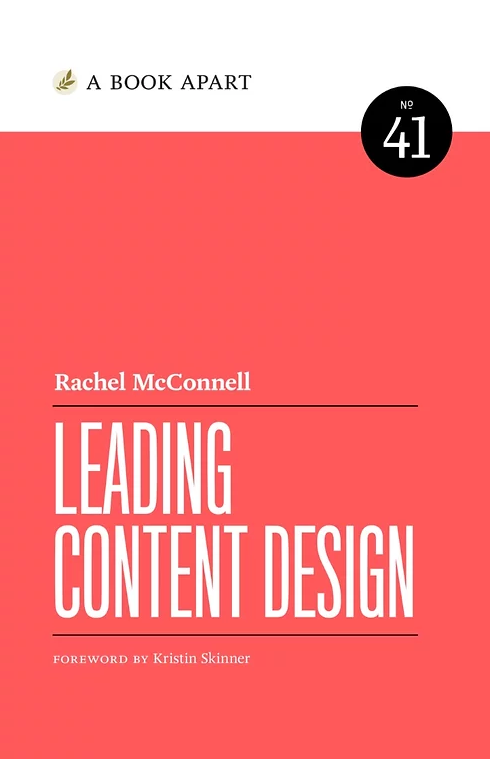By Janus Boye
How do you identify and remove the barriers to strong, effective content work?
Rachel McConnell recently authored ‘Leading Content Design’, where she introduces content operations to help you identify and remove the barriers to strong, effective content work
This is the focus of Rachel McConnell’s recent book Leading Content Design, which shares how to create common standards, improve collaboration, iron out wrinkles in the design process, and build advocacy—so you can lead your team with impact.
Rachel works as Head of UX content at Flo, a women’s health app, and was previously in various content roles at BT. In a recent member call she told us more about the book and emphasised how content operations is all about people.
Below I’ve shared my notes from the call and the Q&A that followed. At the end, you can also view the entire recording, download the slides and find a few links for additional reading.
What is content operations really?
In recent years, we’ve seen an increased amount of content designers and also an improved understanding of the operational side of content. Rachel opened her deck with this crisp definition:
Operations is a core part of content leadership and key to delivering product content strategy.
As she said, content operations is all about making sure you have the right people, processes, tools and systems in place to work effectively and efficiently, and it helps your team to scale with impact. She shared the below slide to illustrate the different tasks and deliverables.
All the activities that make up content operations as laid out by Rachel McConnell
Rachel openly admitted, that she didn’t realise she was doing ops, before she saw it described in a job ad. She wrote the book to help anyone in a similar situation, and other content leaders, think more operationally.
While she wrote the book, she made a brief survey on Twitter to gauge the focus on the operational side of content:
As you can see from the embedded tweet, most respondents barely thought of it.
Rachel also made it clear, that operations isn’t about defining guidance such as tone or voice, setting the strategic direction, or managing content or people.
In the questions and answers part of our member call, a good point was made, to also remember the internal audience. It’s not just about content operations for the website, it’s also for internal communications.
How content operations and strategy work together
To Rachel, it’s quite simple: Operations help your overall business objectives and make it happen. It’s what enables your plans and optimises the implementation.
While strategy can be on many levels, operations are the activities listed above to actually get the work done. In her view, content design is actually doing the work - or designing with words if you like.
As shown on the 6 steps below, you see what the Strategist and Ops person(s) do on each stage.
Rachel also came with a clear call to action when it comes to getting started. To quote:
We don’t always need an ops team or operations person to focus on how we deliver the work. Any of us can start to think more operationally and spend time removing the barriers
Identify your pain points to improve the experience
Leading Content Design came out in March, 2022 and is published by A Book Apart, a boutique publisher which focuses on brief books for people who design, write, and code
As she dived into the topic, she suggested starting your journey in your organisation by identifying pain points. She did this by asking a bunch of questions, including:
What should the content designers be doing and what are they actually doing?
What’s the desired outcome vs. the actual?
What categories do the issues fall into?
In her recent years, she’s done many interviews with both stakeholders and team members to better understand the content situation and to suggest improvements.
One of her deliverables that she showed in the slides was an impressive experience map. Basically starting from the beginning when someone joins a content team, onwards to them getting an understanding of the product strategy, producing work and all the way to going live, measuring, sharing success and developing new skills.
For each phase, she then outlined what someone should be doing and what they are actually doing. She also tried to go from pain points to ‘how might we’ statements and with all this insight, she then worked to identify the highest impact solutions.
In particular, she mentioned that the quotes from talking to employees were really insightful, giving a glimpse into their working days and understanding both pains and priorities. This could both serve the purpose of being eye-opening to others not aware of the pains faced by colleagues, and also help make the link from individual contributions to the company goals.
Learn more about leading content design
Rachel has written extensively on the topic and her first book titled Why you Need a Content Team and How to Build one came out in 2018.
On Rachel’s content leadership website, you can also find some really good related material among her work and writings, including:
We’ve also written about content operations on this blog in the past. See these two popular posts:
Content Operations? How To Collaborate On Content Effectively (2019)
The Organisation-Wide Reality Of Investing In Content Operations (2020)
Finally, you can also download the slides (PDF) or lean back and enjoy the recording from the call below.




